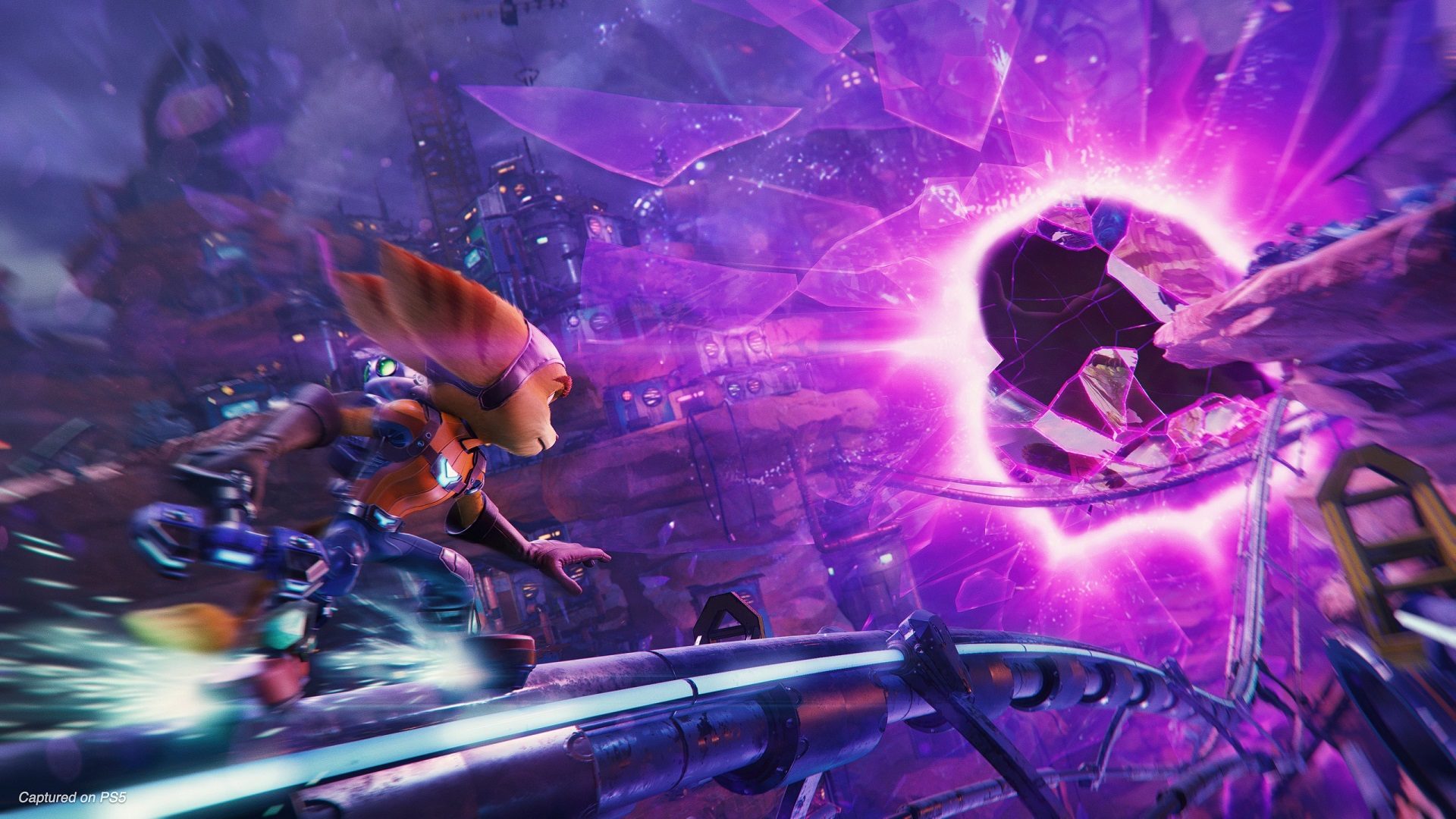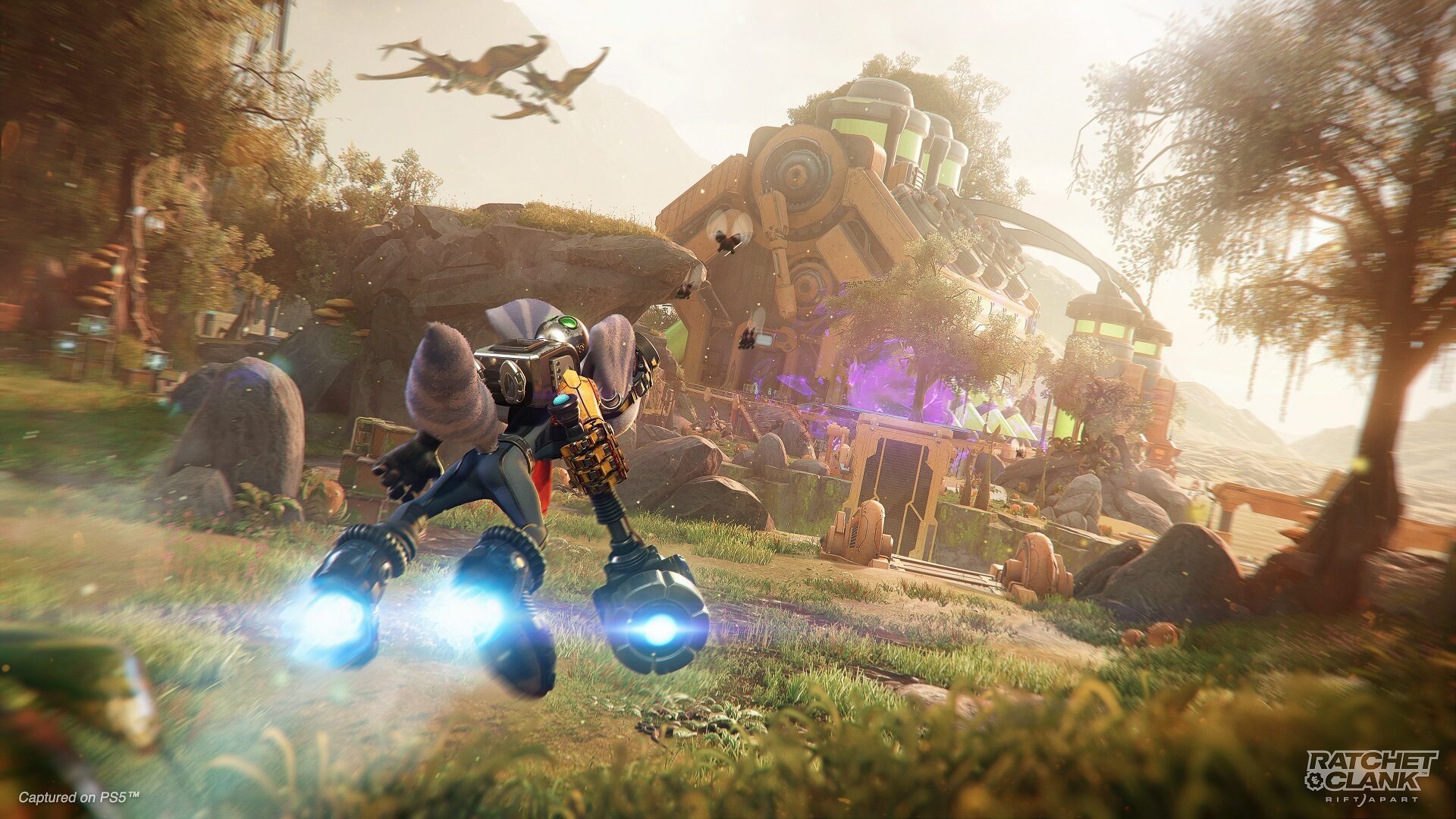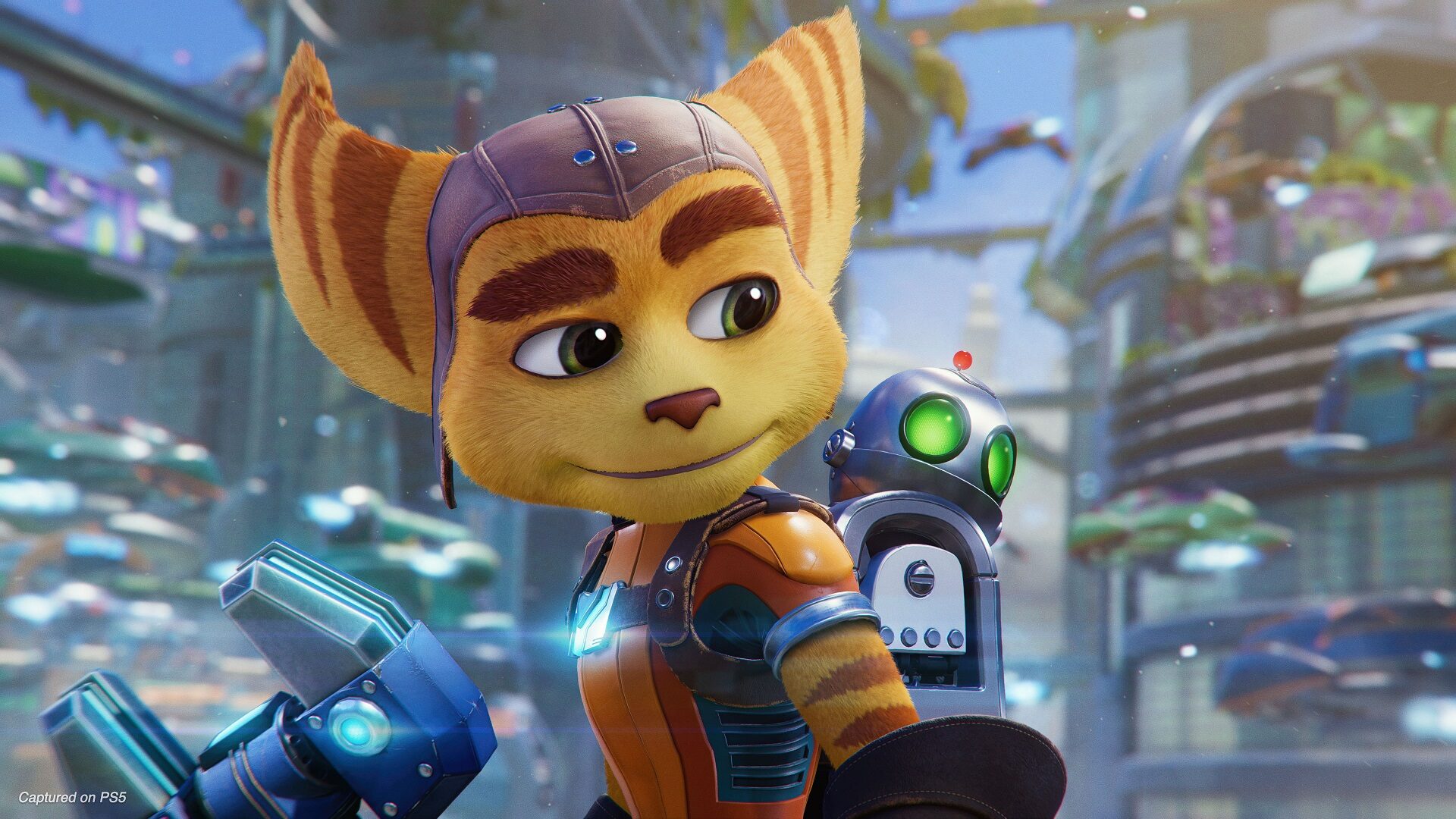I’m not someone who 100-percent completes games. I just don’t do it. Life is fleeting, and the idea of spending my precious moments on Earth chasing map markers and picking up floating, glowy collectibles fills me with existential dread.
So I mean this as the highest praise when I tell you that I 100-percent completed Ratchet & Clank: Rift Apart and still felt like I wanted more.
That’s not to say that Rift Apart doesn’t offer enough. It offers more heart and fun than any game I’ve played in a long while. What I’m saying is that I completed 100 percent of the game because I didn’t want it to end. It’s that good.
Maybe it’s unfair, but Rift Apart definitely had to live up to certain expectations. It is, after all, one of the PlayStation 5’s first exclusives, and the first retail game developed by one of its first-party studios that we get to play. In other words, it has the opportunity to be a selling point—not just for the PS5 but for the ninth generation of consoles in general. Not only that, but it also has the opportunity to bring its titular characters—who have of late felt like second fiddles compared to Sony’s more realistic, blood-soaked mascots in Kratos, Nathan Drake, and Ellie—back to the PlayStation’s main stage.
In both cases, Insomniac Games has exceeded expectations.

From its opening moments, Ratchet & Clank: Rift Apart feels like a next-gen title. After briefly introducing the series’ new character, Rivet, Rift Apart shows us what’s going on in the life of Megalopolis’ longtime heroes, Ratchet and Clank. The city has shown up to celebrate the duo after their years of service, throwing them a parade, and Insomniac uses this visual spectacle to make a statement. Right from the get-go, the visuals take full advantage of the PlayStation 5’s hardware, showcasing a detailed, expansive, futuristic cityscape that had me going into the game’s Photo Mode before I even started playing—just so I could get a prolonged look at Insomniac’s work.
It’s no exaggeration to say that Rift Apart is one of the most stunning games I’ve ever seen. Every expansive level is packed with the kinds of high-resolution details you’d expect from a next-gen title, yes, but Insomniac’s artists have outdone themselves. Both the characters and the landscapes that they’ve created exude an affable, cartoonish energy. The colors are vibrant and everything feels full of life. This will probably become a cliché in reviews of this game, but it truly does feel as if you’re playing a Pixar movie. A couple of the areas—notably Torren IV, which includes one of the game’s most exciting on-rails moments—can cause the frame rate to stutter, but for the most part Rift Apart is a smooth experience. At least, as smooth as the Fidelity Mode’s 30 frames per second can reasonably be.
Choose Your Mode, But Choose Wisely (Or Don’t)
Ratchet & Clank: Rift Apart offers three different visual modes to play in. There’s the Fidelity, Performance, and Performance RT, and each have their positives and negatives.
Fidelity offers the highest visual quality with native 4K resolution and ray tracing, but it maxes out at 30 frames per second. Performance retains a lot of the textural detail of Fidelity mode and runs at 60 FPS, but you’ll be missing out on ray tracing and the resolution is a variable 4K (so not native). Performance RT mode runs at 60 FPS and includes ray tracing, but the visuals definitely take a hit and the resolution looks even less like native 4K than standard Performance.
Really, it all comes down to personal preference. I played through the entire game in Fidelity mode (as the day-one patch that introduced the Performance modes wasn’t available until a couple of days ago), and I didn’t miss the 60 frames per second. However, once I was able to test Performance and Performance RT, going back to 30 FPS definitely made Ratchet and Rivet feel sluggish. I liked Performance mode’s higher visual quality at 60 FPS, but I also missed the ray tracing that Fidelity offered. Performance RT brings some of that ray tracing back, but it definitely didn’t look as good as Fidelity, and the textures were similarly less impressive than they were in standard Performance.
The good news is that you can change the visual mode whenever you want from the game’s options menu; you’ll just have to reload from your last checkpoint when you make the switch. Luckily, Rift Apart is pretty generous with its checkpoints, so don’t worry too much about that. Just don’t change it in the middle of an action sequence.
Rift Apart looks great when you’re just standing around, admiring the scenery, but it looks even better in action because Insomniac’s animators have done a stellar job in making every moment feel alive. There are subtler touches, like the way certain weapons have moving parts that will twist and twitch in the Lombaxes’ hands, and there are the big, explosive setpieces. Most satisfying is the way that enemies react to your attacks; one of my personal favorite weapons, the Ricochet, will knock enemies from side to side with Looney Tunesesque exaggeration. It’s no small feat that, amid the chaos of Rift Apart’s fireworks show of particle effects, the game never feels so visually overwhelming that you can’t tell what’s happening, thanks to the readability and clarity of the animations.
Another way that Insomniac adds to the game’s immersion is how it utilizes the DualSense’s haptic feedback and, yes, even its built-in speaker. I’m not someone that’s been as sold on the DualSense’s advertised features as the general gaming public seems to be, but Rift Apart might have made me a believer. The subtlety of how the game utilizes the controller’s haptic feedback definitely adds to the immersion, as you can feel every step, jump, swing, and boost that Ratchet and Rivet make in the palms of your hands.
What surprised me was how much the controller’s improved built-in speaker added to making you feel like you’re in the Lombaxes’ world(s). Collecting a ton of bolts all at once creates the satisfying kachinging of a slot machine spitting out coins, and dodging enemy attacks with the game’s new Phantom Dash emits an appropriate, transdimensional whoosh. Every weapon has its own sound effect, too, and sometimes this even helps the gameplay. The aforementioned Ricochet rounds, for example, give you a signal when you can hit the enemy again, letting you time a higher-damage follow-up shot. I usually play video games with headphones, but the controller’s sound effects kept my audio coming out of the TV just so that I could savor the tiny auditory details.
The other major way that the PS5 adds to Rift Apart’s immersion is its solid state drive. Thanks to the SSD, there are barely any load times, and Insomniac seems to have cleverly hidden what load times there are in cutscenes and brief transitional animations like Ratchet or Rivet taking off in a spaceship. There are a couple of elevator moments—you know, when your character gets in an elevator so that the game can load the next area—but Ratchet and Rivet won’t be squeezing between any conveniently placed rocks just to give the game time to catch up. From a technical standpoint, it’s very impressive, but from a storytelling perspective, it’s crucial.

Speaking of story, Rift Apart shows that PlayStation studios don’t always need to go to the Deadly Dad well to source a fantastic and rich narrative. Obviously, Insomniac has proven time and time again that it can weave a compelling story, most recently with its Spider-Man games, but Rift Apart brings depth to the series in a way that’s slightly unexpected. Ratchet and Clank do get their moments in Rift Apart, but the introduction of Rivet (and several other alternate-dimension characters that I’d rather not spoil in the review) has, in a way, given Insomniac an out. While Ratchet and Clank live in a world where they’re always defeating Nefarious, Rivet lives in a dimension where she’s always losing. Because of this, Insomniac has more room to explore the darker side of the kinds of heroics that Ratchet and Clank are known for, and it creates more opportunities for ups and downs throughout the game’s story. Don’t get me wrong—Rift Apart isn’t a dour or (shudder) gritty take on the Ratchet & Clank universe. It’s just slightly weightier, slightly more tragic, while still functioning as a good-humored, adventurous romp.
Rift Apart’s gameplay is maybe the least surprising thing about the game. In short, it’s Ratchet & Clank but bigger and bolder. Ratchet and Rivet’s arsenal is larger than it’s ever been. By the end of my initial playthrough I had earned 17 weapons; after defeating the last boss, the game gave me an additional 2 to bring into Challenge mode (which is back from previous titles), and I earned the last weapon by finding all of a certain collectible. All told, Rift Apart gives you 20 weapons to use and upgrade with raritanium, and they’re all incredibly fun to use. Best of all, Ratchet and Rivet share the exact same inventory, so you don’t have to worry about missing your favorite weapon when the story subs in one character for the other. (You will also periodically take control of Clank to solve a handful of interdimensional puzzles, which are thankfully short and more fun than the previous game’s Clank moments. On top of that, Ratchet has a new, tiny robot pal named Glitch who stars in a few basic shooter sequences. They’re nothing special, and they don’t show up that often, but they do manage to lend themselves to the pacing of the game and serve as nice distractions every now and then.)
Part of what makes the weapons so fun to use is the effects they have on the enemies themselves. I know that sounds obvious, but Rift Apart goes the extra distance to make sure weapons feel viable, no matter who you’re fighting. Take the Topiary Sprinkler, for example. Easily one of my favorite gadgets I’ve ever used in any video game, the Topiary Sprinkler is basically a turret that sprays nearby enemies, freezing them and covering them in leaves for a short period. Not only is it incredibly useful, but the visual effects of the enemies basically turning into hedges is satisfying and occasionally comical, given how it freezes them in place in real time. It’s the kind of gadget that, in other games, might not have the same effect on screen-filling bosses. But in Rift Apart, even the biggest enemies in the game can be turned into living bushes for a time. It’s the kind of attention to detail and consistency that has nothing to do with the power of the PS5 and everything to do with Insomniac’s dedication to creating an immersive experience for the player.

There are other noteworthy gameplay additions that Rift Apart brings to the series. The aforementioned Phantom Dash adds an invincibility-frame dodge that makes the chaos of Ratchet & Clank battles feel a little more skillful. But it’s a new traversal mechanic in the form of hover boots that make the most meaningful contribution to exploring Rift Apart’s fairly sizable levels. Not only is the normal hover mode a faster way to travel than simply sprinting with your legs like a chump, but you can even go into a boost mode that will send Ratchet and Rivet rocketing around a level. And this isn’t just an ability that you get during specific, high-speed chase sequences; it’s something that you can utilize anytime you want. It might not sound like a huge deal, but the smoothness and ease of use in hovering around stages makes every other ground-level traversal system in gaming feel, well, pedestrian.
Certain levels will also feature alternative modes of travel, like a dragon or a giant bug, but the uses for these things are slightly more situational. Still, they’re great fun to ride on, and the dragon in particular made me wish that Insomniac still had the rights to a certain purple, winged, horned drake.
The worst thing I can say about Ratchet & Clank: Rift Apart is that it’s very safe. It won’t challenge your expectations in any way, and it won’t change the landscape of the action-platformer genre. In other words, the worst thing about it is that it isn’t revolutionary. This is a Ratchet & Clank game through and through, and it doesn’t do anything different to convince players who don’t like the series to give it another go. Instead, it sticks with what it knows and focuses on being an excellent early title for the PlayStation 5—maybe one of the best early-generation titles ever released. More importantly (at least for fans of the series), Rift Apart gives Insomniac even more characters to explore and stories to tell.

Images: Sony Interactive Entertainment
|
★★★★★
Ratchet & Clank: Rift Apart is the first game I’ve played since the ninth-generation consoles launched that feels like a true next-gen title. Insomniac Games has done everything that it needed to do in making both a sequel to its longest-running franchise and a true next-gen exclusive. While it might not technically be a PlayStation 5 launch title, it feels like one—a real preview of the console’s capabilities. But beyond that, Rift Apart is just an absolute blast to play. |
Developer Insomniac Games Publisher Sony Interactive Entertainment ESRB E10+ - Everyone 10+ Release Date 06.15.21 |
| Ratchet & Clank: Rift Apart is available on PlayStation 5. Primary version played was for PS5. Product was provided by Sony Interactive Entertainment for the benefit of this coverage. EGM reviews on a scale of one to five stars. | |

Michael Goroff has written and edited for EGM since 2017. You can follow him on Twitter @gogogoroff.